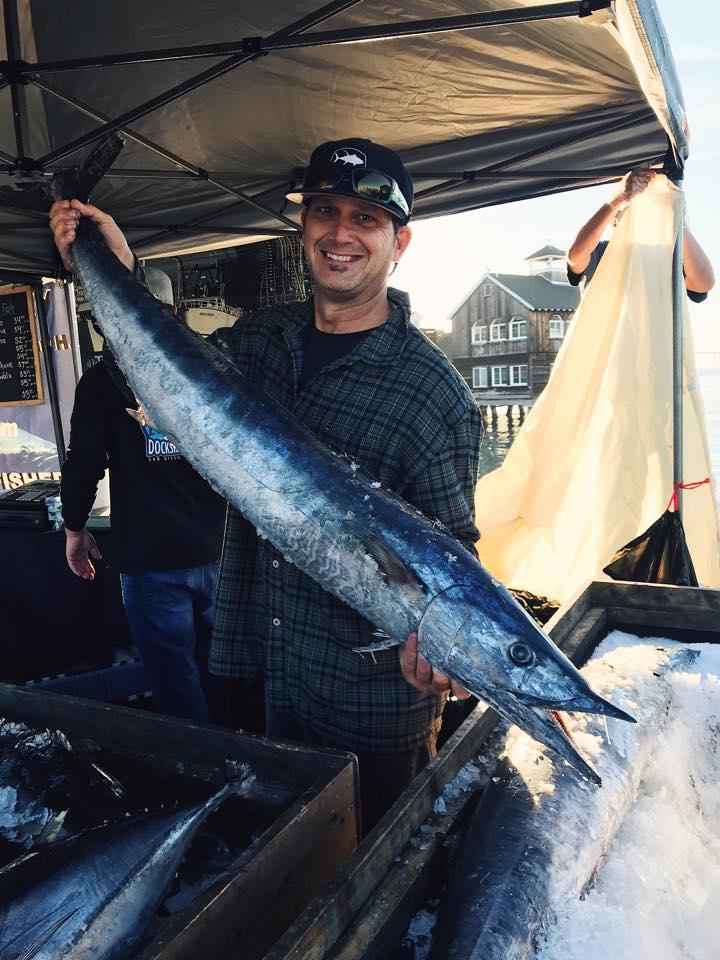Pacific wahoo
Acanthocybium solandri
The Science
THE SCIENCE
Ferocious predators: this fish is thought to be able to eat fish larger than itself by using its sharp, serrated teeth to tear prey into bite-sized pieces. [1]

Taxonomic description
- Has a streamlined body with metallic blue on top and pale blue on underside, 25-30 vertical stripes running from head to tail. [1]
- Averages 1-1.6m (3.3-5.4 ft) in length, but can grow up to 2.4m (8 feet) and weigh up to 71.7 kg (158 lbs). [1]
- Has a long snout and large mouth with triangular, compressed, serrated teeth that allows it to capture and tear chunks out of its prey. [1]
Distribution
- Found in tropical and subtropical waters worldwide (Atlantic, Indian, and Pacific Oceans), and its range may expand to higher latitudes during the warmer season. [1,2]
Life history
- Reproduction occurs year-round in tropical waters and during summer months at higher latitudes. [1]
- Females will release thousands of eggs to be externally fertilized by males, and spawning occurs multiple times per year. [1]
Habitat
- Pelagic, hunts its prey with terrifying bursts of speed. [3]
- Feeds mainly on fish, including frigate mackerel, butterfish, porcupine fish, and round herring. [1]
The Fishery
THE FISHERY
In 2016, recreational landings of Pacific wahoo totaled more than 1.07 million pounds! [5]

Seasonal availability
- Caught year-round. [4]
Regulatory and managing authority
- Along the Pacific West Coast, the fishery is overseen by NOAA fisheries and, as established by the Magnuson-Stevens Act, the Pacific Fishery Management Council through the West Coast Highly Migratory Species Fisheries Management Plan. [4,5]
- As established by the Marine Life Management Act, the California Department of Fish and Wildlife (CDFW) collects data on this fishery. [12]
Gear type
- Usually caught by troll, longline, and hook and line. [4]
- Also caught as bycatch by fisheries targeting tuna. [4]
Status of the fishery
- The fishing rate and population status of Pacific wahoo is not well known as scientists do not formally assess Pacific wahoo populations. [4]
- Regulations and improved gear reduce bycatch and accidental captures. [4]
Potential ecosystem impacts
- There are few impacts on the seafloor as the gear used in this fishery do not typically come into contact with the seafloor. Bycatch may sometimes be an issue, but it is relatively small as there is no directed fishery for Pacific wahoo. [1]
The Seafood
THE SEAFOOD
Wahoo can be cooked in a similar style to tuna, and takes very well to marinades. [6]


Edible portions
-
Found as fillets, steaks, H&G (head and guts removed), and whole. [4]
Description of meat
-
Raw wahoo meat is a lighter pale-pink, and has less red than mackerel. When cooked it turns white and has a firm, lean texture and large, circular flake. It has a mild taste. [6]
-
When cooked, it tastes like lean tuna. [6]
Culinary uses
- This fish can be broiled, grilled, poached, sauted or smoked. It has a low fat content, so the meat can dry out when cooking. [6]
- For a recipe for grilled wahoo with mango salsa, visit Local I'a. [7]
- For a Malaysian fish curry recipe that can be substituted with wahoo, visit Kuali. [13]
Nutritional information
- Nutritional information based on 100g of raw Pacific wahoo is available on the table to the right. [5]
Toxicity report
- Wahoo can have elevated levels of mercury, so this fish should only be eaten occassionally. [4]
Seasonal availability
- This fish is available year-round. [4]
References
[1] NOAA Fisheries. n.d. Pacific Wahoo. Web. https://www.fisheries.noaa.gov/species/pacific-wahoo. Accessed 9 July 2020.
[2] Luna, S.M., Kesner-Reyes, K. n.d. Acanthocybium solandri. Web. https://www.fishbase.se/summary/89. Accessed 9 July 2020.
[3] Oceana. n.d. Wahoo (Acanthocybium solandri). Web. https://oceana.org/marine-life/ocean-fishes/wahoo. Accessed 9 July 2020.
[4] Fish Choice. 2020. Wahoo. Web. https://fishchoice.com/buying-guide/wahoo. Accessed 9 July 2020.
[5] Fishwatch. 2019. Pacific Wahoo. Web. https://www.fishwatch.gov/profiles/pacific-wahoo. Accessed 10 July 2020.
[6] SeafoodSource. 2014. Wahoo. Web. https://www.seafoodsource.com/seafood-handbook/finfish/wahoo. Accessed 22 July 2020.
[7] Local I'a. n.d. Grilled Ono with Mango Salsa. Web. http://localiahawaii.com/recipes/15-grilled-ono-with-mango-salsa. Accessed 22 July 2020.
[8] Dove, A. 2015. iNaturalist. Photo of Pacific wahoo. Digital image. Web. https://www.inaturalist.org/photos/12872614. Accessed 22 July 2020.
[9] craigjhowe. 2020. iNaturalist. Wahoo. Digital image. Web. https://www.inaturalist.org/observations/37244184. Accessed 10 February 2021.
[10] Tuna Harbor Dockside Market. 2019. Facebook. Digital image. Web. https://www.facebook.com/thdocksidemarket/photos/2467870353242233. Accessed 10 February 2021.
[11] stu_spivack. 2006. flickr. Wahoo. Digital image. Web. https://www.flickr.com/photos/stuart_spivack/111132511/. Accessed 10 February 2021.
[12] Marine Life Management Act. n.d. California Department of Fish and Wildlife. Web. https://wildlife.ca.gov/Conservation/Marine/MLMA. Accessed 24 August 2020.
[13] Rusli, R. Kuali. n.d. Ikan Tenggiri Masak Lemak Pucuk. Web. https://www.kuali.com/recipe/fish-seafood-dishes/ikan-tenggiri-masak-le…. Accessed 29 January 2021.



